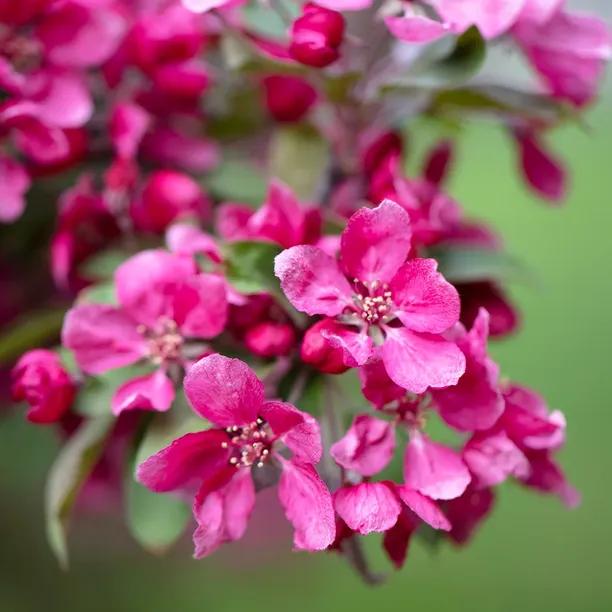Liset Crab Apple, Trees
Honest Delivery Prices- Holland. Deep red buds & fruit, lighter red flowers. Purple young leaves.
- Max. Height: 6-8m
- Bareroot Delivery: Nov-Mar.
Recommended extras
Description
Malus × moerlandsii Liset: Bareroot Liset Crab Apple Trees in Standard Sizes
Liset's display begins with bright, strawberry red buds, which are slowly covered up by the young foliage in spring, which is a rich purple colour that becomes greener as it matures but never fully disappears, providing a good backdrop to the flowers. These are the stars of the show, with luminous red-pink petals that swarm all over the tree, second only to a cherry blossom in sheer weight of beautiful flowers. It is often mistaken for a flowering cherry at a distance, and her crab apples are also a bit cherry like: shiny, very dark red fruit about 1.5cm across. They finish off this tree's long season of interest, hanging on longer than the leaves and decorating the branches as winter closes in. Some can cling on into the new year, unless the birds take them.
Lisette can grow to 8 metres if unmanaged, but 6 metres is more likely, and she has a dense, compact growth habit that responds well to pruning into an open, rounded form. Half standards will reach approximately 4 metres.
Browse our variety of crabapple trees or see our full range of ornamental garden trees.
Delivery season: Crab apple trees are delivered bareroot during late autumn and winter, approximately November-March inclusive.
Choosing a size: Small trees are cheaper, easier to handle and more forgiving of less than ideal aftercare, so they are best for a big planting project. If instant impact is your priority, or if you are only buying a few plants for use in a place where it is convenient to water them well in their first year, then you may as well use bigger ones. All our bareroot trees are measured by their height in centimetres above the ground (the roots aren't measured).
Features:
- Height: 6m
- Soil: Any well drained
- Use: Specimen, small garden, urban
- Colour: Striking red-pink flowers in April-May
- Dark red-purple, small, decorative fruit
- Bareroot delivery only: November-March
Growing Liset Crab Apples
She is a hungry feeder and needs a rich, moist soil with a good amount of sun to thrive. Tolerant of pollution.
Mature trees tend to develop temporary cracks on their bark, especially in years with good summers. These are normal, and heal the same year that they form, but they do make the tree quite susceptible to scab in the warmer, more humid parts of the East and South of England and Wales.
Planting Instructions
Notes on planting Malus Liset:
Crabapples are tough plants that thrive in any moderately fertile soil. They tolerate shade well, although we recommend planting them in full sun to get the best display of flowers and fruit. Although a moist, well drained site is ideal, crabapples like heavy clay and don't mind a bit of waterlogging in winter.
They won't grow in deep shade and may struggle in very poor dry soil.
Prepare your site before planting:
It is good to dig over the site where you plant a tree several months in advance. Kill the weeds first: for tough weeds like nettles, brambles and ground elder, you will usually need a weed-killer to get rid of them. When you dig the soil over, remove stones and other rubbish and mix in well rotted compost or manure down to the depth of about 2 spades.
Watch our video on how to plant a tree for full instructions.
Remember to water establishing trees during dry weather for at least a year after planting.
Tree Planting accessories:
Prepare your site for planting by killing the weeds and grass.
You can buy a tree planting pack with a wooden stake & rubber tie to support the tree and a mulch mat with pegs to protect the soil around the base of your tree from weeds and drying out.
We suggest that you use mycorrhizal "friendly fungi" on the roots of all newly planted large trees: if your soil quality is poor, we strongly recommend it.
You can also improve your soil with bonemeal organic fertiliser.
Did You Know?
This tree was bred in Holland in the early 1950's from Profusion by Simon Doorenbos (1891-1980), who also bred the Snow Queen birch.
Standard trees are measured by their girth in centimetres 1 metre above ground level: their trunk's waist measurement. Unlike sapling trees and hedge plants, standards aren't measured by their height, which will vary quite a bit both between and within species.
So, a 6/8cm standard tree has a trunk with a circumference of 6-8cm and an 8/10 standard has a trunk 8-10cm around. This measurement makes no difference to the tree's final height.
On average, standard trees are 2-3.5 metres tall when they arrive, but we cannot tell you precisely how tall your trees will be before we deliver them.



